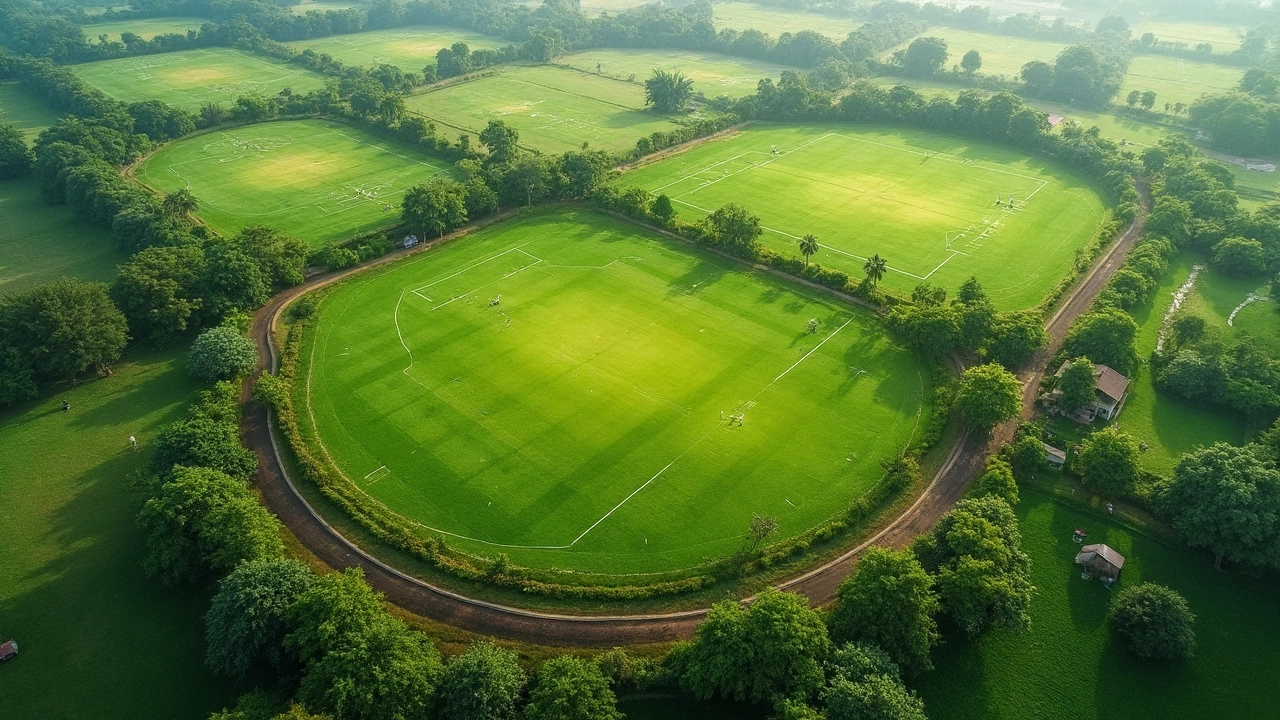100 acres sounds massive, but it's tough to picture unless you've seen that amount of land up close. Most people have a better handle on something like a football field. Curious how the two stack up? The answer might actually surprise you.
Pull out your mental yardstick: a standard American football field (including the end zones) measures 360 feet long and 160 feet wide—so 57,600 square feet total. An acre is 43,560 square feet, which means a football field is a bit bigger than an acre. So, if you lined up football fields, 100 acres would fit about 75 football fields side by side. Suddenly, 100 acres feels a lot bigger than just a ‘big backyard’.
- 100 Acres in Football Fields: The Math
- Visualizing 100 Acres for Buyers
- Why Size Comparison Helps Land Shoppers
- Common Mistakes When Thinking About Acreage
- Tips for Evaluating Land Before You Buy
100 Acres in Football Fields: The Math
If you’re looking at 100 acres and wondering what that looks like compared to a football field, you’re not alone. The numbers clear it up quick. One football field (with end zones) takes up about 57,600 square feet. One acre is only 43,560 square feet. So, a football field is about 1.32 acres.
How do you turn acres into a number of football fields? Here’s the step-by-step math, so you don’t need to guess:
- Start with 100 acres (the typical size a lot of sellers throw around).
- 100 acres × 43,560 square feet per acre = 4,356,000 square feet.
- Divide that big number by the size of a football field (57,600 sq ft).
- 4,356,000 ÷ 57,600 = about 75.7 football fields.
That means 100 acres gives you almost 76 football fields’ worth of room. That’s a ton of space to work with if you’re buying land for sale for hunting, development, or just bragging rights.
Here’s a quick table showing the comparison:
| Measurement | Square Feet | Acres | # of Football Fields |
|---|---|---|---|
| 1 acre | 43,560 | 1 | 0.76 |
| 1 football field | 57,600 | 1.32 | 1 |
| 100 acres | 4,356,000 | 100 | 75.7 |
So, next time someone mentions 100 acres, just picture nearly 76 football fields laid out next to each other. That’s the kind of scale you’re looking at when it comes to large land for sale.
Visualizing 100 Acres for Buyers
Trying to wrap your head around 100 acres is tricky if all you’ve got is numbers, so let’s draw some real-world comparisons. In most neighborhoods, a single suburban lot is about a quarter-acre. That means 100 acres could fit around 400 typical house lots. Imagine how many families (or cars, or basketball hoops) could fit out there.
If you prefer a simpler comparison, think about a shopping mall parking lot. A Walmart Supercenter, including its parking lot, averages about 20 acres. So, 100 acres is like five full Walmart sites sitting right next to each other. That’s serious space to play with.
If you’re looking at the sports angle, as mentioned earlier, you’re talking about the size of roughly 75 football fields. Seeing them all lined up is wild—it would take you more than half an hour to walk from one end to the other at a normal pace.
| Land Type | Approximate Size in Acres | How Many Fit into 100 Acres |
|---|---|---|
| Average House Lot | 0.25 | 400 |
| Walmart Supercenter (with parking) | 20 | 5 |
| American Football Field | 1.32 | 75 |
Don’t forget, 100 acres isn’t always a perfect rectangle—properties can be oddly shaped. This means your actual layout could look super different once you walk it or see aerial photos. For anyone scouting land for sale, especially big pieces, bring a map and, if you can, try using a drone or Google Earth for perspective. There’s nothing like seeing that huge open space to really drive home the scale.

Why Size Comparison Helps Land Shoppers
Figuring out how big 100 acres really is can feel overwhelming, especially if you don’t work with land every day. Comparing big plots to something common, like football fields, turns a random number on paper into something you can actually imagine. It’s the difference between staring at a giant price tag and knowing what you’re really getting.
When sellers or agents toss around terms like “sprawling” or “ample,” your brain doesn’t latch on to a picture. But say, “This property could fit 75 football fields,” and suddenly you have a mental snapshot. You know exactly if you could fit a ranch, an event venue, or even a small neighborhood on it.
Even seasoned land investors use size comparisons. Why? Because land isn’t flat or perfect—it can have forests, slopes, or ponds that shrink usable space. Seeing it in football fields gets everyone on the same page before setting foot on the lot.
- Football field comparisons give buyers a sense of scale—especially for land for sale.
- It makes it easier to talk with family or partners who might not know much about real estate measurements.
- Planning for farming, building, or splitting up land gets much simpler when you can say, “We’ve got room for X number of fields.”
According to the National Association of Realtors, more than half of first-time land buyers report confusion with land sizes. Using football fields cuts down misunderstandings and even helps avoid costly mistakes from over- or underestimating a property’s potential.
| Unit | Size (sq ft) | 100 Acres Equivalent |
|---|---|---|
| Acre | 43,560 | 100 |
| Football Field | 57,600 | ~75 |
Seeing the numbers side by side like this, you’ll have a much clearer handle on just how big 100 acres is the next time you’re browsing land listings or walking a property boundary.
Common Mistakes When Thinking About Acreage
People often misjudge land size because acreage isn’t something you see or measure every day. One of the biggest mistakes is assuming all “100 acre” plots look the same. That’s not the case—even if two spots are both 100 acres, the shapes can be wildly different. Long and skinny? Good luck using that as farmland. A compact square is usually easier to manage.
Another mix-up is confusing the size of an acre with a football field. An acre is actually smaller—about 76% the size of a standard American football field. Don’t fall into the trap of thinking you’ll fit 100 football fields into a 100-acre lot—they won’t all squeeze in perfectly due to the numbers.
People also forget about features that eat up usable space. Trees, creeks, rocky hills, or even weird property lines can all reduce the amount of land you can actually use. Real estate agent Kelly Jones says,
“What looks like 100 acres on paper could feel a whole lot less when you’re walking it. Buyers should always see the lay of the land before getting too excited.”
- Assuming all 100-acre plots are equal—layout and shape really matter.
- Ignoring slopes or uneven terrain, which can make a chunk of land way less practical.
- Not accounting for roads, easements, or neighbors’ access rights that might slice into your usable space.
- Underestimating just how far you’ll have to walk or drive from one end to the other.
Here’s a quick comparison to make things clearer:
| Area Type | Size (sq ft) | Percentage of 1 Acre |
|---|---|---|
| 1 Acre | 43,560 | 100% |
| Football Field | 57,600 | 132% |
If you’re buying or selling land, remember the details matter. Walk the property, pay attention to the shape, and don’t let the idea of "100 acres" fool you into making a quick decision. Bringing a map or using drone footage can help you get the real picture, not just a number.

Tips for Evaluating Land Before You Buy
Before jumping into a purchase, compare your target property’s size with something you know—like football fields. Visual cues help avoid disappointment or confusion after the deal closes. Here’s where things get real with acreage: 100 acres easily covers 75 full football fields, but what does that mean for you as a buyer?
- Walk the Boundaries. Don’t just look at a satellite map. Most properties feel smaller or larger in person. A walk around gives you a gut-check for just how much space you’re really buying.
- Investigate Zoning and Permits. Check with the county—zoning laws affect what you can actually do with the land. A chunk of land that size could be ideal for farming, development, or recreation, but local rules might throw you a curveball.
- Utilities and Access Matter. Raw land often means no water, electric, or even road access. Getting those set up can drive up costs. Ask about these before you make an offer, especially with land for sale advertised as "off the grid."
- Use a Surveyor. Only a professional survey tells you exactly where your boundaries are. Tax records, old deeds, and even fences can be way off. Skipping this step is a rookie mistake.
- Topography and Soil Check. Flat and fertile land is super valuable, but rocky, swampy, or steep patches can be a headache. A soil or topo report will save you from nasty surprises later.
If you’re weighing out a serious investment—say, in 100 acres—don’t be afraid to ask for previous land use records or get a soil quality test. Lenders and insurance companies sometimes require it anyway, especially for big parcels or potential agri-business.
| Factor | Why It Matters |
|---|---|
| Access/Easements | You need legal access to use your property or build anything |
| Flood Risk | Flood zones impact insurance price and what you can build |
| Utility Hookups | No power or water? Prep for extra expenses |
| Development Potential | Zoning laws and city planning can raise or kill property value |
| Topography/Soil | Impacts future uses, building costs, and resale value |
Thinking about a purchase this big? Don’t just rely on paper measurements or bird’s-eye views. Real value and usability come down to what's actually on and around those 100 acres. Smart buyers do their homework, double-check details, and save themselves from headaches later.







Write a comment